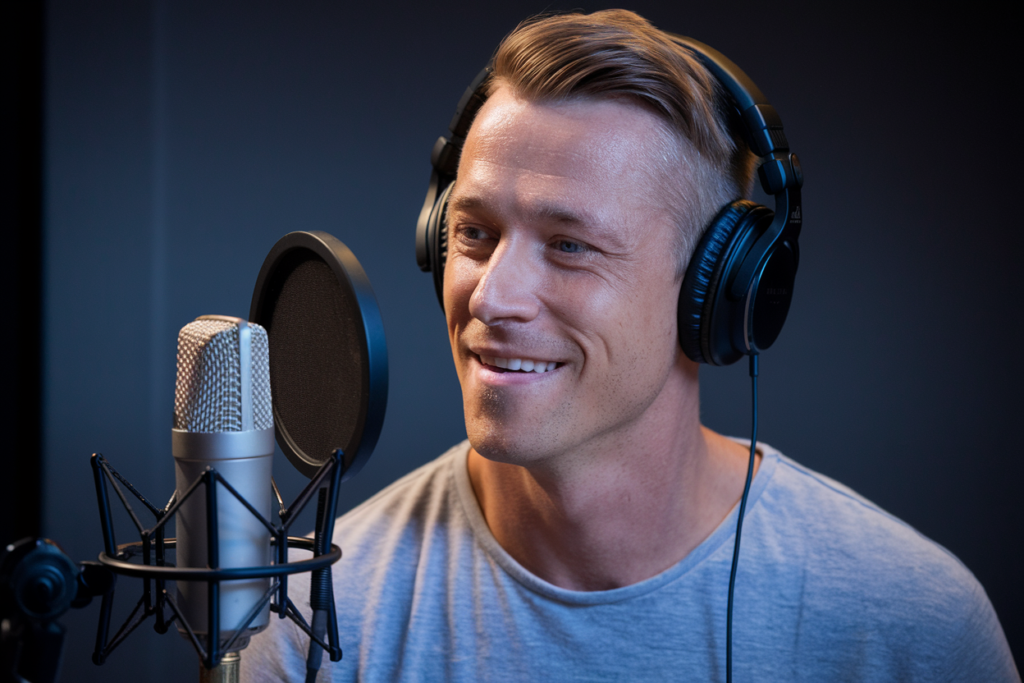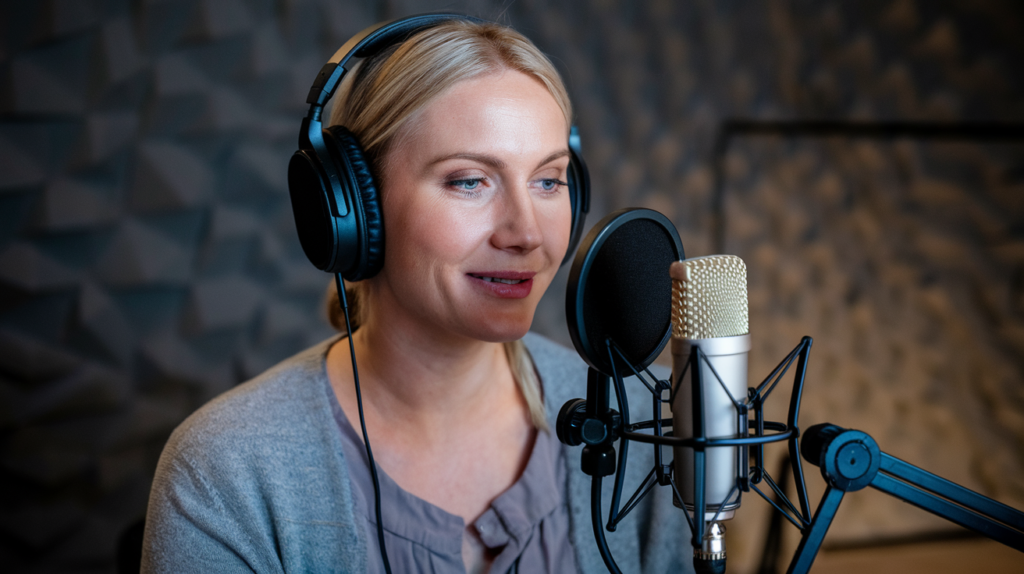Key Takeaways
- Understanding Australian English: Familiarize yourself with the unique pronunciation, slang, and intonation of Australian English to enhance authenticity in voiceovers.
- Recognizing Regional Variations: Acknowledge the different accents and dialects across Australia (Broad, Cultivated, General) to tailor your voiceover approach effectively for various audiences.
- Importance of Quality Voiceovers: Professional voiceovers enrich media content by improving brand identity, comprehension, and engagement while fostering trust through localized accents.
- Essential Recording Equipment: Invest in high-quality microphones (like Audio-Technica AT2020 or Rode NT1-A), pop filters, shock mounts, and suitable recording software (Audacity or Adobe Audition) for optimal audio capture.
- Effective Techniques for Voice Recording: Integrate warm-up exercises, modulation practices, and clear enunciation techniques to ensure a smooth and engaging delivery in your recordings.
- Cultural Nuances & Common Phrases: Understanding cultural references and practicing common Australian phrases will deepen your connection with local audiences and enhance your overall performance.
Ever wondered how to make your Australian English voiceovers stand out? Whether you’re a budding voice artist or a seasoned pro, nailing that authentic Aussie accent can be tricky. It’s not just about the words; it’s about capturing the unique rhythm and tone that resonate with listeners.
Understanding Australian English
Australian English features unique traits that set it apart from other English dialects. It’s vital to grasp these nuances for effective voiceovers in this style, as they enhance authenticity and connection with the audience.
Key Characteristics
Australian English has distinct pronunciation patterns, vocabulary, and idiomatic expressions. For instance:
- Pronunciation: Vowel sounds differ significantly from American or British accents. Words like “mate” sound more elongated.
- Slang: Australians often use colloquial terms such as “arvo” (afternoon) or “bikkie” (biscuit). Familiarity with these adds warmth and relatability.
- Intonation: The rhythm tends to be more musical, with a rising inflection at the end of statements sometimes used for emphasis.
Understanding these characteristics allows you to deliver voiceovers that resonate well with local audiences while showcasing your skills as a voice artist.
Regional Variations
Australia is diverse, leading to regional variations in its English. Different areas exhibit unique accents and slang that may influence your voiceover work:
- Broad Accent: Commonly found in rural areas; it’s characterized by strong vowel shifts.
- Cultivated Accent: More refined; often associated with educated speakers in urban environments.
- General Accent: Represents the most widespread form of Australian English; it’s neutral enough for broader appeal.
By recognizing these differences, you can tailor your approach as a voice actor, ensuring your delivery aligns with specific audiences across Australia.
The Importance of Voiceovers
Voiceovers play a crucial role in shaping the audio landscape across various platforms. They add depth and personality to content, making it more engaging for your audience.
Role in Media and Advertising
In media and advertising, voiceovers are essential for conveying messages effectively. A skilled voice artist brings scripts to life, enhancing storytelling through tone, cadence, and emotion. Whether it’s a commercial, documentary, or animated feature, the right voiceover talent can captivate listeners and create an emotional connection with your brand. Think about how often you hear a memorable voice that sticks with you long after the ad ends—it’s all about that impact.
Benefits for Businesses
Utilizing professional voice actors offers numerous benefits for businesses. First, quality voiceovers enhance brand identity by adding a unique sound that resonates with target audiences. Second, they improve comprehension; clear narration helps convey complex ideas simply and understandably. Third, effective voiceovers increase engagement; dynamic delivery keeps viewers interested throughout presentations or advertisements. Incorporating localized accents like Australian English adds authenticity as well—this detail fosters trust among local customers who appreciate relatable representation.
Investing in top-notch voiceover services elevates your messaging strategy while ensuring that your content stands out in a crowded marketplace.
Equipment Needed for Recording
When it comes to recording Australian English voiceovers, having the right equipment makes a significant difference. You’ll want gear that captures your unique voice and delivers high-quality audio.
Microphones and Accessories
Choosing the right microphone is crucial for any voice artist. Consider a condenser microphone; its sensitivity captures detailed vocal nuances. Popular models include the Audio-Technica AT2020 and the Rode NT1-A, known for their clarity and warmth.
Don’t forget accessories like pop filters, which reduce plosive sounds, and shock mounts that minimize vibrations from handling noise. A good mic stand ensures stability during recording sessions, allowing you to focus solely on your performance.
Recording Software Options
Selecting suitable recording software completes your setup. Programs like Audacity offer user-friendly interfaces while providing powerful editing tools without breaking the bank. If you’re looking for more advanced features, consider Adobe Audition or Logic Pro X.
Ensure your software supports high-quality formats such as WAV or AIFF to maintain audio integrity during post-production. Familiarizing yourself with these options enhances your workflow and allows you to produce polished voiceovers that resonate with listeners.
Techniques for Effective Voice Recording
Mastering the art of voice recording involves a blend of preparation and technique. You want your voiceovers to sound authentic and engaging, particularly when capturing the essence of Australian English. Here are some techniques that can elevate your recordings.
Warm-Up Exercises
Warming up your voice is crucial before diving into any recording session. Consider these exercises:
- Humming: Start with gentle humming to relax your vocal cords.
- Lip trills: Create a buzzing sound while blowing air through closed lips. This helps with breath control.
- Tongue twisters: Practice phrases like “She sells sea shells” to enhance clarity and articulation.
Incorporating these warm-ups into your routine prepares you for optimal performance, ensuring your delivery sounds smooth and natural.
Voice Modulation and Clarity
Voice modulation adds depth and interest to your recordings. It’s about varying pitch, tone, and volume to convey emotion effectively. Here’s how you can enhance this aspect:
- Pitch variation: Shift between high and low pitches to express different feelings or emphasize key points in your script.
- Controlled pace: Adjusting your speed keeps listeners engaged—slow down during important messages or speed up when conveying excitement.
- Clear enunciation: Focus on pronouncing words distinctly, especially challenging Australian slang or idioms.
These techniques help ensure that every word resonates with clarity, drawing listeners into the narrative you’re presenting as a voice artist.
Tips for Success in Australian English Voiceovers
Achieving success in Australian English voiceovers requires an understanding of both the language and its cultural context. Focus on the nuances that make your delivery authentic and engaging.
Understanding Cultural Nuances
Cultural references play a significant role in connecting with an audience. Familiarize yourself with local customs, current events, and popular culture to enhance your voiceover work. Incorporate relevant idioms or phrases, as they resonate more deeply with listeners. For instance, using terms like “fair dinkum” (genuine) or “she’ll be right” (everything will be okay) adds authenticity to your performance. Recognizing regional variations also helps you tailor your approach—what appeals to audiences in Melbourne might differ from those in Brisbane.
Practicing Common Phrases
Practice makes perfect when it comes to voiceovers. Focus on common Australian phrases that capture everyday speech patterns. Use expressions such as “How’s it going?” or “Let’s catch up later” during rehearsals to develop natural rhythm and intonation. Record yourself while practicing these phrases; playback will reveal areas for improvement and help refine your delivery style. Engaging with native speakers can further enhance your fluency and comfort level, allowing you to embody the essence of Australian English effortlessly.
By honing these skills, you’ll not only improve your craft but also connect more authentically with your audience through every word spoken in your recordings.
Conclusion
Mastering Australian English voiceovers involves more than just pronunciation. It’s about capturing the unique essence and rhythm that make your delivery resonate with listeners. By understanding regional accents and incorporating local slang, you can create a connection that feels genuine.
Investing in quality equipment and honing your recording techniques are essential steps toward achieving professional results. Remember to engage with the cultural context of Australia to enrich your performances.
With practice and dedication, you’ll elevate your voiceover work, making it stand out and leaving a lasting impression on your audience.
Frequently Asked Questions
What is an authentic Australian English voiceover?
An authentic Australian English voiceover captures the distinct rhythm, tone, and pronunciation of Australian English. It involves mastering unique vocal traits like elongated vowel sounds, colloquial slang (e.g., “arvo” for afternoon), and a musical intonation that resonates with listeners. Achieving this authenticity connects better with the audience and enhances engagement.
Why is mastering regional variations important in voiceovers?
Mastering regional variations such as Broad, Cultivated, and General accents allows voice artists to tailor their delivery to specific audiences across Australia. Understanding these nuances ensures that the performance feels genuine and relatable, which can significantly improve audience connection and effectiveness in communication.
What equipment is essential for recording Australian English voiceovers?
Essential equipment includes a high-quality condenser microphone like the Audio-Technica AT2020 or Rode NT1-A, along with accessories like pop filters and shock mounts to enhance sound quality. Using suitable recording software such as Audacity or Adobe Audition will also ensure polished audio output for professional results.
How can I prepare my voice for recording?
Preparation techniques include warm-up exercises such as humming, lip trills, and tongue twisters to loosen your vocal cords. Practicing pitch variation, controlled pacing, and clear enunciation will also help you achieve a more engaging delivery while ensuring clarity in your recordings.
What tips can improve my Australian English voiceover skills?
To enhance your skills, familiarize yourself with local customs and popular culture. Incorporate relevant idioms like “fair dinkum” into your performances to add authenticity. Additionally, practice common phrases by recording yourself and engage with native speakers to naturally embody the style of Australian English in your work.







